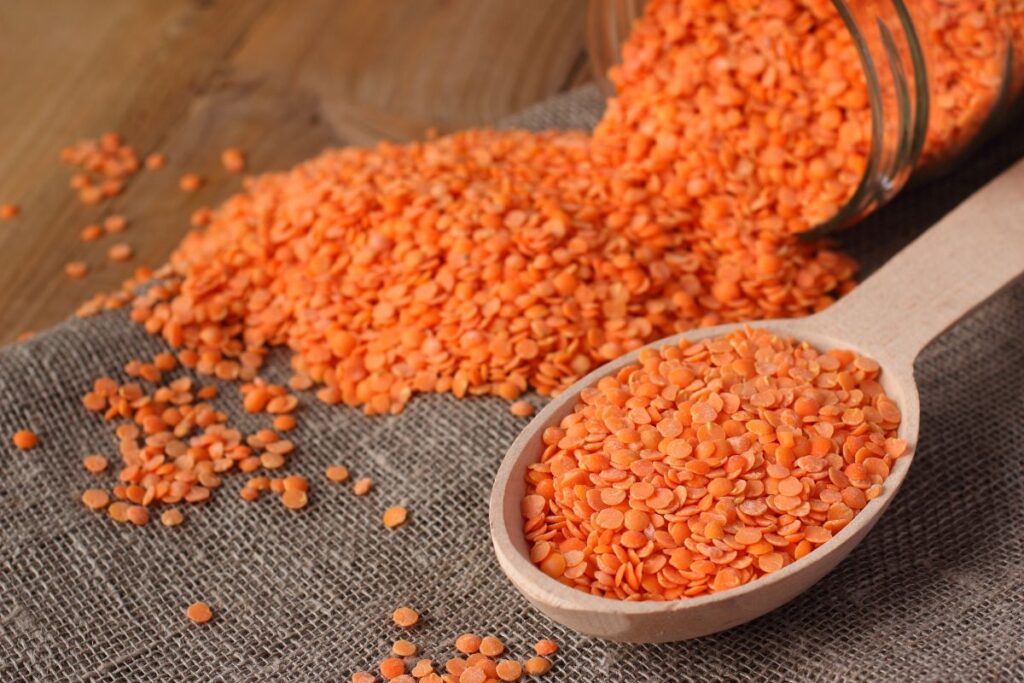Red lentils have long been a staple in kitchens around the world, especially in Middle Eastern, Indian, and Mediterranean cuisines. Loved for their quick cooking time, earthy flavor, and rich nutrition, these tiny legumes pack a powerful punch when it comes to health benefits.
Whether you’re vegetarian, vegan, or simply looking to add more plant-based foods to your diet, red lentils are a smart choice.
What Are Red Lentils?
Red lentils are split and hulled lentils, which gives them their distinctive orange-red color. Unlike whole lentils, they cook quickly and break down into a soft, creamy texture, making them perfect for soups, stews, curries, and purees. They are not only versatile in the kitchen but also nutrient-dense and easy to digest.
Nutritional Properties of Red Lentils
Red lentils are packed with essential nutrients, including:
- Protein – A plant-based powerhouse, ideal for muscle repair and overall health.
- Fiber – Supports digestion, satiety, and blood sugar control.
- Iron – Helps prevent fatigue and supports healthy red blood cell production.
- Magnesium & Potassium – Promote heart health and balance blood pressure.
- Folate (Vitamin B9) – Crucial for brain health, cell growth, and pregnancy support.
- Antioxidants – Help protect the body from oxidative stress.
With a low fat content and high nutrient density, red lentils are one of the healthiest legumes you can add to your diet.
Health Benefits of Red Lentils
1. Boost Heart Health
The combination of fiber, magnesium, and potassium in red lentils helps reduce cholesterol levels and regulate blood pressure—two key factors in supporting cardiovascular health.
2. Support Digestion
Rich in dietary fiber, red lentils aid bowel regularity and help maintain a healthy gut microbiome, reducing the risk of digestive issues.
3. Excellent Plant-Based Protein Source
For those who avoid meat or are reducing their intake, red lentils provide a high-quality source of plant protein, making them perfect for vegetarians and vegans.
4. Help Manage Weight
Thanks to their fiber and protein content, red lentils promote satiety, keeping you full for longer and helping to control cravings.
5. Stabilize Blood Sugar
Lentils have a low glycemic index, which means they release energy slowly, preventing blood sugar spikes—a big plus for people managing diabetes or blood sugar fluctuations.
6. Nourish During Pregnancy
The folate content in red lentils plays a critical role in supporting fetal development, making them an excellent addition to the diet of expectant mothers.
Culinary Uses of Red Lentils
One of the best things about red lentils is their versatility. They absorb flavors beautifully and can be used in a wide variety of dishes:
- Soups & Stews – Add body and creaminess without the need for heavy cream.
- Curries & Dals – A staple in Indian cuisine, red lentils cook into a smooth, flavorful base.
- Salads – Toss cooked red lentils with vegetables and herbs for a protein-rich salad.
- Spreads & Dips – Blend into smooth spreads similar to hummus.
- Baking – Add cooked and mashed lentils into bread or muffins for an extra nutrient boost.
Because they cook quickly—usually in 15–20 minutes—red lentils are a convenient, budget-friendly ingredient for everyday meals.

Red lentils are more than just a pantry staple—they’re a nutritional powerhouse that supports heart health, digestion, weight management, and overall wellness. With their mild flavor, creamy texture, and impressive health benefits, they’re an easy and delicious way to enrich your diet.
Whether you’re simmering a hearty soup, preparing a comforting dal, or experimenting with plant-based dishes, red lentils are a small ingredient that makes a big impact.

